Swedenborg, A Hermetic Philosopher – Ethan Allen Hitchcock
The writer of this book desires to say that, in preparing the work, it has been no part of his design to express his individual opinions upon the topics discussed. His purpose has been to suggest the opinions of others, especially of a class of men scarcely recognized as existing in the world. The art they profess, called after the name of Hermes, Hermetic Philosophy, is so little known at the present day that the name of it by no means indicates it. The adepts profess to be, or to have been, in possession of a secret, which they call the gift of God. The art has been prosecuted under many names, among which are Alchemy, Astrology, and even Chiromancy, as well as Geomancy, Magic, &c., under all of which names it has had deluded followers, who have been deceived, as those who claim to be true artists say, not by the art itself, which never ” did betray the heart that loved it,” but by their own selfish passions, which play the Asmodeus with so many that the few who escape delusion are mystical, not to say mythical, beings who are supposed to have lived upon dreams.
Format: Paperback.
Swedenborg, A Hermetic Philosopher.
ISBN: 9783849672690.
Available at amazon.com and other venues.
Swedenborg’s scientific beliefs (from wikipedia.com)
Swedenborg proposed many scientific ideas during his lifetime. In his youth, he wanted to present a new idea every day, as he wrote to his brother-in-law Erik Benzelius in 1718. Around 1730, he had changed his mind, and instead believed that higher knowledge is not something that can be acquired, but that it is based on intuition. After 1745, he instead considered himself receiving scientific knowledge in a spontaneous manner from angels.
From 1745, when he considered himself to have entered a spiritual state, he tended to phrase his “experiences” in empirical terms, to report accurately things he had experienced on his spiritual journeys.
One of his ideas that is considered most crucial for the understanding of his theology is his notion of correspondences. But, in fact, he first presented the theory of correspondences only in 1744, in the first volume of Regnum Animaledealing with the human soul.
The basis of the correspondence theory is that there is a relationship among the natural (“physical”), the spiritual, and the divine worlds. The foundations of this theory can be traced to Neoplatonism and the philosopher Plotinus in particular. With the aid of this scenario, Swedenborg now interpreted the Bible in a different light, claiming that even the most apparently trivial sentences could hold a profound spiritual meaning. Swedenborg argued that it is the presence of that spiritual sense which makes the Word divine.
(The text of the last section was taken from a Wikipedia entry and is available under the the Creative Commons Attribution-ShareAlike License.)
Publisher’s Note: This book is printed and distributed by Createspace a DBA of On-Demand Publishing LLC and is typically not available anywhere else than in stores owned and operated by Amazon or Createspace.

